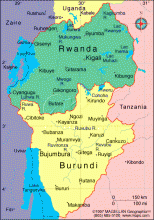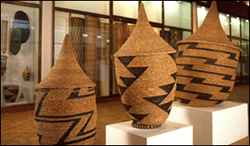By Nikki Mardell
Background of the Hutu Tribe

1: Map of Rwanda/Burundi
The Hutu tribe in East Central Africa mostly live near the Vinga Forest and Lake Tanganyika in the countres of Rwanda and Burundi. The main language spoken by the Hutu tribe is Bantu, a language common with neighboring tribes Twa and Tutsi. Rwanda is close to 1500 meters near it's eastern plateau and 1,500 to 2,000 meters in its north and west boundaries. There are normally two dry and two wet seasons in an average year. The dry season lasts from December to mid March and from June until late August with a small amount of cooling cloud cover, but the atmosphere mostly stays at a pleasant but warm temperature. In the wet season, October through November and mid March to late May, all activity is put on hold so the scorched soil can gather nutrients for the next plating season. The average temperature year round is 76 degrees Fahrenheit. Main sources of economic success are found in agriculture from Rwanda and Burundi's large expanse of savanna and grasses. Main exports in the country today include bananas, sorghum, tea, cacao and coffee. Wild animals are not a common occurrence in Rwanda and Burundi but some goats and cattle are available in the Hutu culture.
Environmental Impact on Culture

2: Traditional Hutu Baskets
Art: The wide open savannas and varying climate of Rwanda and Burundi draws tribes together for survival and support but also have an impact on Hutu art and religion. During the long rainy season when the main bustle of farming and harvesting is put to rest, boredom and the need for expression has caused Hutu people to create baskets, ceramics, paintings, and woodworking pieces. In Hutu art, geometric shapes are very common, focusing on natural tan color of rafia and straw and dyed black materials to show a stark contrast. Music and dance are also largely important in Hutu culture. During celebratory holidays, like the Sorghum harvesting Festival (Rwanda Development Gallery), orchestras of 7-9 drummers form the backbone to performances with Intore or "the chosen ones" dancers, harpists, flutists, and other musicians. (Rwanda Tourism). Instruments such as the ingoma, ikembe, and umuduri and are created with resources given in the environment of Rwanda such as, animal skins, plant fibers, and wood.(African Museum)
Religion: The Hutu were mainly monotheists, believing in Imaana; a mostly human-like but respected god. This god could have been viewed as an earth and sky god similar to other religions of the area. Ancestor spirits or Abazimas were also highly regarded in religion. Gifts and sacrifices were often given to the gods in order to bring good luck and fortune telling was popular in order to keep in contact with the spirits.(Countries and Their Cultures)
Religion: The Hutu were mainly monotheists, believing in Imaana; a mostly human-like but respected god. This god could have been viewed as an earth and sky god similar to other religions of the area. Ancestor spirits or Abazimas were also highly regarded in religion. Gifts and sacrifices were often given to the gods in order to bring good luck and fortune telling was popular in order to keep in contact with the spirits.(Countries and Their Cultures)
